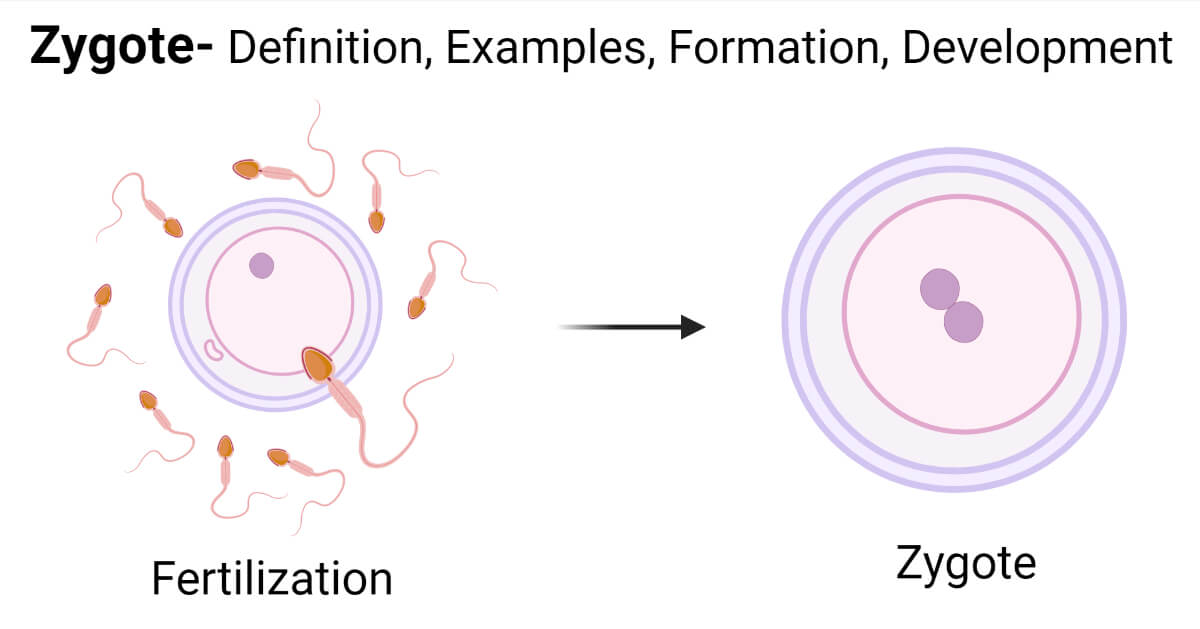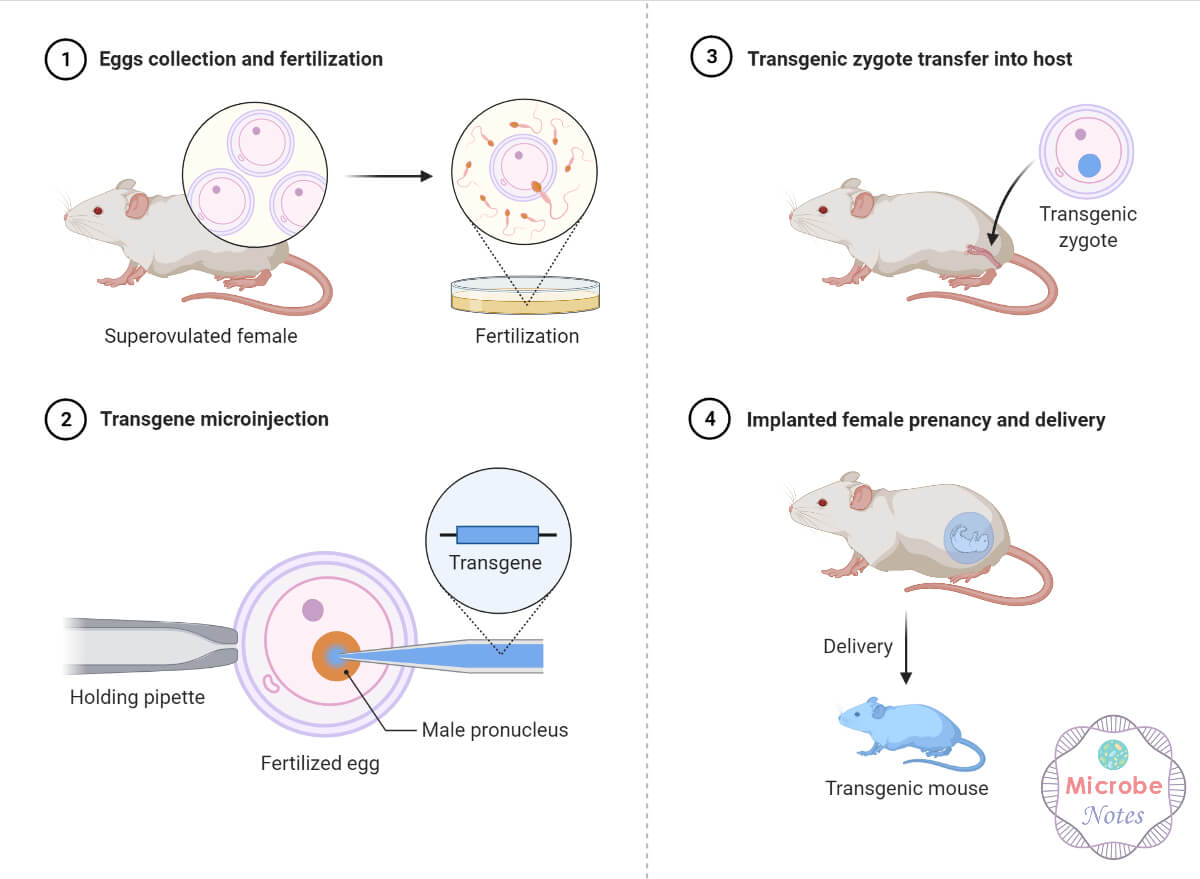Zygote simply can be called a “fused or fertilized cell (ovum)”. It is derived from the Greek word ‘Zygotos’ meaning ‘joined or yoked’.
They are formed by a process called “fertilization”.
The zygote contains a diploid set of chromosomes; half from the male gamete (father) and the remaining half from the female gamete (mother).
A zygote is the starting point of a new sexually reproducing eukaryotic individual. Zygote ensures species continuation and species variation. The genetic trait of a developing individual will depend on the genes of male and female gametes fused to form the zygote. Zygote ensures diploid chromosomes in offspring.
Zygotes usually divide mitotically and develop into a multicellular blastocyst which will, in turn, develop into an embryo. However, in some haploid fungi, the division of zygote will occur meiotically to form haploid fungi.
Interesting Science Videos
What is a Zygote?
A zygote is the first diploid eukaryotic cell that resulted from the fusion of haploid gametes (sperm and an ovum) during sexual reproduction. It is the initial stage of an embryo from which a multicellular organism develops. It is also seen in unicellular organisms, where instead of becoming embryos they multiply to give offspring.

Zygote Examples
Zygotes are formed in all sexually reproducing diploid or polyploidy organisms. Based on their different characters, some examples of zygotes are:
1. Fungi zygote
It is also called zygospore. Fungi bodies are haploid mycelium. They develop into male and female gametes, in the Gametophytic stage, which will fuse to form a fungal zygote. This process is called karyogamy.
2. Human zygote
A human zygote is formed in the fallopian tube when male sperm fertilizes the mature female ovum released from an ovary. Initially, human zygotes are seen to contain 4n chromosome numbers for a temporary period, but soon they mitotically divide into 2 cells each with 2n chromosomes. The human zygote is the most widely studied zygote for a better understanding of human development, embryology, and genetics.
3. Plant zygote
Plants zygotes may be diploid or even polyploidy. Meotically unreduced gametes may fuse to form polyploidy zygote. Zygotes are formed inside a structure called archegonium.
4. Animal zygote
All members of the Animalia kingdom form zygote as their first stage of life. All of animal zygotes are diploid. Animals that have an internal fertilization system will form a zygote in a fallopian tube inside the body of a female, while fertilization and zygote formation is outside the body in animals with external fertilization.
Formation of Zygote
Simply, a zygote is formed by the fusion of male gamete (sperm) and female gamete (ovum). Generally, a single sperm fuse with a single ovum, but in some cases, multiple sperms are also found to fuse with a single ovum. This process of formation of a zygote is called fertilization
1. Formation of Human Zygote (animal zygote)
- Fertilization is internal in humans i.e. zygote is formed and developed inside the body of a female in a fallopian tube. During sexual intercourse, millions of sperms are ejaculated and about a few hundreds of them will reach the ovum in the fallopian tube.
- The first stage is the penetration of the corona radiata of an ovum by spermatozoa. Several spermatozoa can penetrate this layer.
- The second stage is the penetration of the zona pellucida. Only one of the spermatozoa can penetrate this layer and fertilize the ovum. During this period, sperm modify in a process called sperm capacitation.
- When a spermatozoon hits the plasma membrane of the ovum, a fertilization cone is formed and the spermatozoa enter the ovum.
- Once sperm enters the ovum, they modify, lose sperm tail, and will form male pronucleus.
- When male pronucleus and female pronucleus contact, their membrane fuse, and their chromosomes fuse resulting in a diploid cell, called a zygote. This is the first cell of the organism being developed.
2. Formation of Plant Zygote
- During the pollination process, pollen grains are deposited over the stigma and converted to pollen tubes. The pollen tube then migrates towards the ovary through the stigma and style.
- During migration two gametes are formed inside the pollen tube. When the pollen tube reaches the ovary, it ruptures releasing two male gametes in the embryo sac. The male gametes fuse with the ovum to form a zygote in the double fertilization process. One of the sperm nuclei fuses with the egg nucleus to form a 2n zygote. The next nucleus fuse with the 2n nucleus to form a 3n nucleus which by mitotic division results in endosperm formation.
Development of Zygote (Human Zygote)
- The zygote undergoes mitotic division resulting formation of an embryo which will develop into an individual. The zygote stage is usually very short and is immediately followed by cleavage.
- Initial cleavage of zygote results in two cells called blastomeres. They further divide by mitosis process to form 4 cells, 8 cells, and a solid ball of 16-32 cells, called the morula. Each division occurs at every 12- 24 hours period. Morula undergoes compaction and cellular differentiation and marks another stage called blastulation.

- Cells differentiate into the outer layer called the trophoblast and the inner layer called the embryoblast.
- Following cleavage, the second stage called blastulation starts which will result in the blastocyst. The trophoblast will multiply and form the outer layer surrounding the developing blastula. They also secrete fluids and ultimately will form the placenta in the future. The embryoblast will divide rapidly and polarize at one end leaving a cavity called the blastocoel. The embryoblast will form the pre-embryo, the amnion, yolk sac, and allantois. This stage is now called a conceptus.
- The conceptus then attaches to the endometrium of the uterus and implants for further development. The conceptus evolves into a structure called an embryo at the end of the implantation process. It will then enter the gastrulation stage to form the gastrula and go to the embryonic development stage.
Challenges of Zygote
- Chromosomal fusion during zygote formation may sometimes result in several genetic disorders like Down Syndrome, Turner’s Syndrome, Klinefelter’s Syndrome, etc.
- Formation of the zygote in a plant may not always form 2n (diploid) zygote but may result in polyploidy. This may result in several negative effects on the plant; even new subspecies may arise.
- The human zygote is influenced by maternal drug use, nutritional uptake, physical health, etc. These factors may damage the developing zygote.
- Parent’s age, the viability of eggs and sperms, sperm and ovum health, sex hormones, etc. directly influence the formation and viability of zygote.
- Zygotes may split due to some problems during development and result in the formation of identical twins.
- Zygotes formed due to external fertilization are susceptible to microbial, environmental, and physical factors.

Zygote Vs. Embryo
| Zygote | Embryo |
| It is a diploid cell formed by the fusion of male and female gamete during sexual reproduction. | It is the early developmental stage of multicellular sexually reproducing eukaryotes after the zygote and before the fetus stage. |
| It is the first stage of a body of an individual in form of a single cell, which will later divide to form an embryo. | It is the second stage of an individual formed from the mitotic division of the zygote. |
| The process of formation of the zygote is called fertilization. | The process of formation of an embryo is called embryogenesis. |
| It is unicellular. | It is multicellular. |
| No any body parts or dermal layers are separated. | Dermal parts are separated and several organs and body parts begin to form. |
| In humans and most animals, they are formed and found in the fallopian tube. | In humans and most animals, they are formed and found in the uterus as an implanted stage. |
| They do not change their size. | They increase in size as they begin to develop. |
Zygote Vs. Gamete
| Zygote | Gamete |
| It is a fertilized cell formed by the fusion of male and female gamete during sexual reproduction. | It is the haploid germinal cell produced by gonads. |
| It is a diploid stage. | It is a haploid stage. |
| Formed by the fusion of gametes. | Formed by meiotic division of germ cells. |
| In humans and most animals, they are found in the fallopian tube. | They are formed, found, and matured in gonads. |
| They are formed inside the female body only. | The male gamete is formed inside the male body, while the female gamete is formed inside the female body. |
| They undergo mitotic division rapidly after formation. | The cell cycle is arrested and doesn’t further divide. |
| They develop into an embryo. | They fuse to form a zygote. |
References
- Zygote | Interactive Biology, with Leslie Samuel (interactive-biology.com)
- Biology:Zygote – HandWiki
- Zygote | Definition, Formation and Examples (ibiologia.com)
- Zygote: Definition, Stages, and Diagram I ResearchTweet
- Zygote – Embryology (unsw.edu.au)
- Zygote – Definition and Examples | Biology Dictionary
- What Is a Zygote? (verywellfamily.com)
- Zygote – Meaning, Development, Formation, and FAQs (vedantu.com)
- What is Zygote?- Definition, Formation, And Development Of Zygote (byjus.com)
- Loredana Papale, Agnese Fiorentino, Markus Montag, Giovanna Tomasi, The zygote, Human Reproduction, Volume 27, Issue suppl_1, 1 August 2012, Pages i22–i49, https://doi.org/10.1093/humrep/des205
- How are zygotes formed in fungi? | Socratic
- Embryonic Development – Embryology (unsw.edu.au)
- Johnson, M.H., Everitt, B. J. (2007) Essential reproduction – 6th ed. Published by Blackwell Publishing. Library of Congress Cataloging-in-Publication Data.
- Kozlovsky P, Gefen A. Sperm penetration to the zona pellucida of an oocyte: a computational model incorporating acrosome reaction. Comput Methods Biomech Biomed Engin. 2013 Oct;16(10):1106-11.
- Fertilization & Implantation- An Overview of Fertilization in Humans (byjus.com)
- Fertilisation In Plants | Mechanism of fertilisation (entrancei.com)
- What is the process of fertilization? – BYJU’S Q&A (byjus.com)
- The Stages of Embryo Development – Path Fertility
- zygote | Definition, Development, Example, & Facts | Britannica
- Development of Human Embryo: Stages, Formation, and Fate of Germ Layer (embibe.com)
- Difference Between Embryo and Zygote | Compare the Difference Between Similar Terms
- Difference between Zygote and Embryo – javatpoint
- Laurie J. Vitt, Janalee P. Caldwell, in Herpetology (Third Edition), 2009
- Problems That Occur During Prenatal Development (verywellmind.com)
- Forgács, G.; Newman, Stuart A. (2005). “Cleavage and blastula formation”. Biological physics of the developing embryo. Cambridge University Press. p. 27. ISBN 978-0-521-78337-8.
